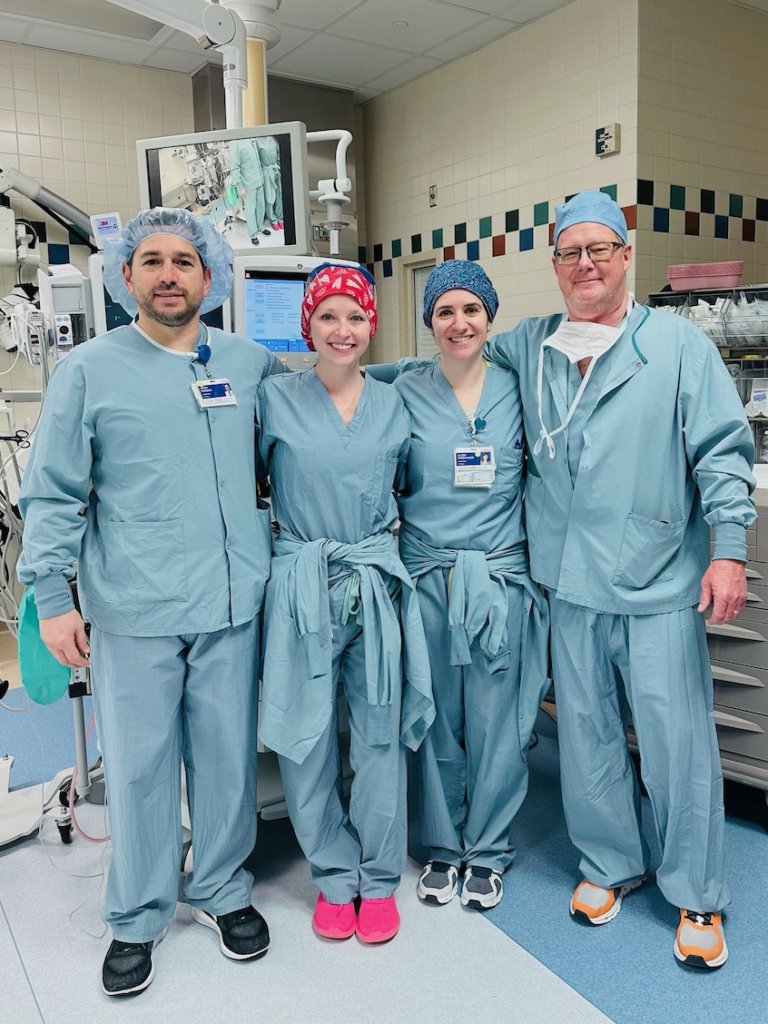Last December, Jamie Applegate, MS, CRNA, encountered a situation most healthcare providers never see in their entire careers. Thanks to her training as a Certified Registered Nurse Anesthetist (CRNA), also known as nurse anesthesiologists or nurse anesthetists, and her attendance at a recent obstetrics workshop, Applegate was prepared. Her actions, along with those of other CRNAs and healthcare providers in the OB operating room/delivery suite, helped save a patient’s life.
Applegate, an AANA member since 2014, had provided anesthesia that day for what she anticipated to be a routine, repeat C-section. CRNAs are highly trained anesthesia professionals who practice in every setting anesthesia is delivered, including operating rooms and obstetrical delivery rooms.
“The baby was delivered, and within just a couple minutes of delivery, Mom and Dad were looking at the baby and smiling. They were waiting for the baby to be cleaned up and brought over from the warming table,” she said. “And then I noticed that the patient’s eyes had rolled back into her head.”
The patient’s arms became very rigid, she started breathing irregularly, and she went unconscious. Immediately, Applegate knew something was wrong.
“Initially, it appeared that she was having a seizure. I grabbed my circuit and started mask ventilating her because she was not breathing effectively. At the same time, I started to call for additional help into the room. I let the OB who was performing the C-section know we were having complications up at the top of the bed.”
Applegate noticed the patient had become bradycardic – meaning her heart rate was below 60 beats per minute, which is abnormally slow. The patient was administered atropine, a medication that’s used in emergency situations where the heart is beating too slowly. However, the patient quickly lost a pulse. The team started CPR and called a code blue, Applegate said. The patient had also started bleeding, which required massive blood transfusions.
“I instructed one of the nurses in the room to grab the GlideScope®, and I intubated the patient. Thankfully, intubation was uncomplicated,” she said.
Soon after intubation, Applegate determined the patient was having an amniotic fluid embolism (AFE), a rare and catastrophic pregnancy complication in which the amniotic fluid enters the mother’s pulmonary circulation, causing cardiovascular collapse. The mortality rate for AFE can be as high as 60%.
In the past year, Applegate had attended a conference where she was introduced to the “A-OK” protocol, which involves the administration of three drugs (atropine, ondansetron, and ketorolac) that have shown to lead to restoration of a patient’s circulation and successful resuscitation, according to AANA’s Analgesia and Anesthesia Guidelines for the Obstetric Patient.
With the diagnosis of an AFE event, Applegate instituted the “A-OK” protocol. The patient had already been given atropine for the bradycardia, but once the protocol was put into action, she was also given 8 milligrams of ondansetron and 30 milligrams of ketorolac, which completed the three drugs in the algorithm.
Applegate said providers came from all over the hospital to help, including CRNAs, physician anesthesiologists, anesthesia technicians, cardiologists, nurses, nurse practitioners, and an OB doctor. The other CRNAs included AANA members Alison Greenwood, CRNA; Raymond Johnson, CRNA; Jason Saineghi, CRNA; Katie Totten, CRNA; and Jessica Wisser, CRNA. She praised everyone who came to help, stressing that it was a team effort to save the patient’s life.
“We resuscitated the patient for almost 40 minutes before we had a return and spontaneous circulation,” she said.

Reflecting on the incident now, Applegate described it as a “blur.”
“It’s one of those moments that you fear in your career and hope never happens to you,” she said. “I’m so grateful that I went to that conference, and I was in the right place at the right time. I was able to implement those three medications during the resuscitation, and I don’t know if that alone was lifesaving. It was the entire team that worked on the patient that day. I’m incredibly grateful for everyone that was there to assist in resuscitating her.”
Applegate couldn’t stop thinking about the patient afterward. For almost every day of the next week, she visited the patient in the ICU, including the day the patient was extubated. The patient said she physically wasn’t able to talk for very long, but she was happy to be alive. Applegate remembered thinking how grateful she was that the patient could tell her that.
“She had a large, blended family at home and a lot of kids waiting for her, including her new baby. I was just so grateful that she was going to be able to go home and be with them. Not only did she survive, but she survived neurologically intact. It was one of the most important days of my career so far as a nurse anesthetist.”
Following the AFE incident, Applegate worked with her manager to educate others in the department on the life-saving protocol. She also ensured there were signs about the “A-OK” protocol posted in the hospital’s OB suites in case a scenario like this one would happen again.
“Some people never see this at all in their career. I pray that it never happens again, but if it does, I feel more prepared,” she said.